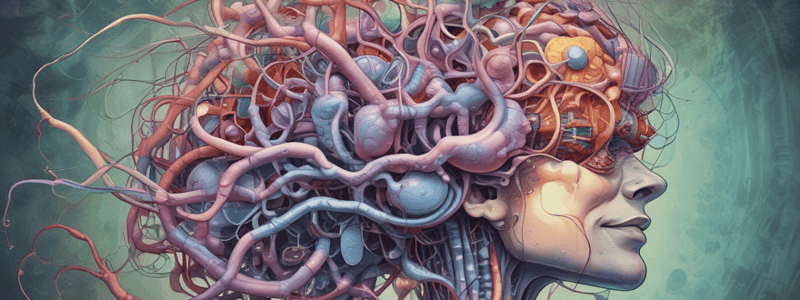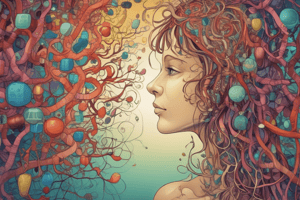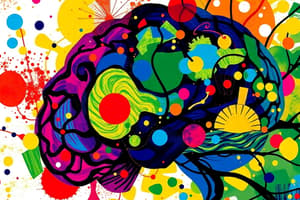Podcast
Questions and Answers
Which of the following neurotransmitters is paired with the protein marker tyrosine hydroxylase?
Which of the following neurotransmitters is paired with the protein marker tyrosine hydroxylase?
- GABA
- Glutamate
- Acetylcholine
- Dopamine (correct)
What is the primary way to classify drugs according to their neurotransmitter system?
What is the primary way to classify drugs according to their neurotransmitter system?
- By their chemical structure
- By the transmitter system they act upon (correct)
- By their side effects
- By their mechanism of action
Which enzyme is involved in the synthesis of serotonin?
Which enzyme is involved in the synthesis of serotonin?
- Tryptophan hydroxylase (correct)
- Choline acetyltransferase
- Tyrosine hydroxylase
- Glutamic acid decarboxylase
What is the name of the receptor paired with the neurotransmitter glutamate?
What is the name of the receptor paired with the neurotransmitter glutamate?
Which of the following neurotransmitters is an amino acid?
Which of the following neurotransmitters is an amino acid?
What is the name of the enzyme involved in the synthesis of nitric oxide?
What is the name of the enzyme involved in the synthesis of nitric oxide?
What is the primary mechanism of action of dopamine agonists in the treatment of Parkinson's disease?
What is the primary mechanism of action of dopamine agonists in the treatment of Parkinson's disease?
Which type of CNS-acting drug is used to treat epilepsy?
Which type of CNS-acting drug is used to treat epilepsy?
What is the primary mechanism of action of acetylcholinesterase inhibitors in the treatment of Alzheimer's disease?
What is the primary mechanism of action of acetylcholinesterase inhibitors in the treatment of Alzheimer's disease?
Which stage of neurotransmission is NOT a potential site of drug action?
Which stage of neurotransmission is NOT a potential site of drug action?
What is the primary mechanism of action of selective serotonin reuptake inhibitors in the treatment of depression and anxiety?
What is the primary mechanism of action of selective serotonin reuptake inhibitors in the treatment of depression and anxiety?
Which of the following CNS-acting drugs can interfere with neurotransmission?
Which of the following CNS-acting drugs can interfere with neurotransmission?
What is the primary mechanism of action of dopamine antagonists in the treatment of schizophrenia?
What is the primary mechanism of action of dopamine antagonists in the treatment of schizophrenia?
What is the primary site of action of CNS-acting drugs?
What is the primary site of action of CNS-acting drugs?
Which of the following neurotransmitters is NOT classified as a biogenic amine?
Which of the following neurotransmitters is NOT classified as a biogenic amine?
What is the primary purpose of reuptake in the process of chemical transmission?
What is the primary purpose of reuptake in the process of chemical transmission?
Which of the following is an example of a diffusible mediator?
Which of the following is an example of a diffusible mediator?
What is the primary function of receptor-induced increase or decrease in ionic conductance?
What is the primary function of receptor-induced increase or decrease in ionic conductance?
Which of the following is a criterion for a chemical to be considered a neurotransmitter?
Which of the following is a criterion for a chemical to be considered a neurotransmitter?
What is the purpose of metabolism in the process of chemical transmission?
What is the purpose of metabolism in the process of chemical transmission?
Which of the following neurotransmitters is an opioid?
Which of the following neurotransmitters is an opioid?
What is the purpose of retrograde signalling in the process of chemical transmission?
What is the purpose of retrograde signalling in the process of chemical transmission?
Flashcards are hidden until you start studying
Study Notes
Neuropharmacology
- The lecture explores cellular and molecular sites of drug action in the CNS, the diversity of transmitters, and the process of neurotransmission.
Sites of drug action in the CNS
- Receptors: dopamine agonists (Parkinson's Disease), dopamine antagonists (Schizophrenia)
- Ion channels: sodium channel blockers (epilepsy)
- Enzymes: acetylcholinesterase inhibitor (Alzheimer's Disease)
- Transporter: selective serotonin reuptake inhibitor (depression/anxiety)
Types of receptors in CNS
- Figure 3.1 shows an illustration of receptors in CNS
- Figure 3.2 shows an illustration of receptors in CNS
Neuropharmacology – general principles
- Drugs can act via regulating transmitter release, reuptake, metabolism, or act directly on neurotransmitter receptors
- Many commonly used CNS drugs can interfere with neurotransmission
- The precise mechanism of action of many therapeutically useful CNS drugs is unknown
Stages of neurotransmission
- Action potential in presynaptic nerve
- Synthesis of transmitter (increase, decrease, or enhance)
- Storage
- Metabolism
- Release
- Reuptake (nerve or glia)
- Degradation
- Receptor binding (activation, enhance, or inhibit activation)
- Receptor-induced increase or decrease in ionic conductance
- Retrograde signalling
Chemical transmission in CNS synapses
- Criteria for transmitter:
- Transmitter made/stored in vesicles
- Transmitter released upon nerve stimulation
- Action is terminated in some way
- Exogenous application mimics effects of nerve stimulation
CNS Neurotransmitters
- Biogenic Amines: serotonin, dopamine, noradrenaline, adrenaline, acetylcholine
- Amino acids: GABA, glutamate
- Peptides: opioids (endorphin), tachykinins (substance P), neuropeptide Y (NPY)
- Purines: ATP, adenosine
- Diffusible mediators: nitric oxide, carbon monoxide
Chemical transmission in the CNS
- Critical features:
- Release of transmitter
- Activation of receptor(s)
- Breakdown (enzyme) or removal of transmitter from the synapse
- Note: there is much redundancy in transmitter functions, and many neurotransmitters may serve similar functions
- Anatomic specificity: particular circuits have specific neurotransmitters
Key markers of neurotransmission
- Glutamic acid decarboxylase (GABA)
- Tyrosine hydroxylase (dopamine, noradrenaline, adrenaline)
- Tryptophan hydroxylase (serotonin)
- Choline acetyltransferase (acetylcholine)
- Neuronal nitric oxide synthase (nitric oxide)
Brain cell types
- No specific information provided
Neuropharmacology – drug classification
- Classification according to transmitter system (e.g. dopamine or acetylcholine)
- Classification according to application or indication (e.g. antidepressant, antipsychotics, anxiolytics)
Studying That Suits You
Use AI to generate personalized quizzes and flashcards to suit your learning preferences.




